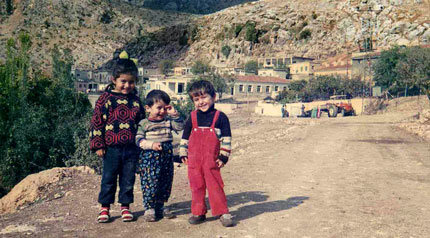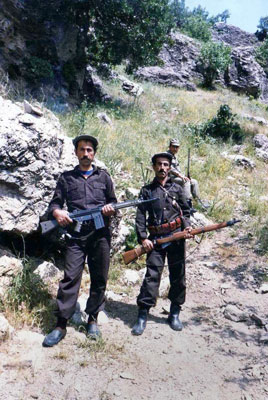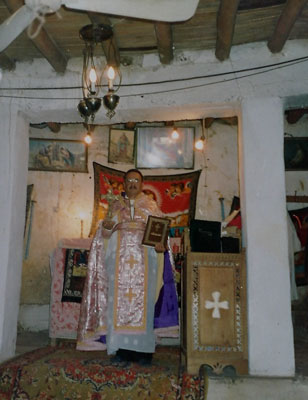|
Three pictures visualize different aspects of life in the Assyrian village of Hassana. It is all over now, the village is deserted, its inhabitants emigrated to safer but also unfamiliar parts of the world. The pictures preserve the memories. Days of war and peace in the shadow of Mount Judi in southeastern Turkey. (ATH)
 Panoramic view on Hassana - in the sunshine of their smile
The gravel road, coming from the plain and running into the foothills of Mount Judi, ends in lower Hassana. This is the new part of the village, with the Turkish army barracks, the medical aid station and the primary school. The newly built Chaldean church is situated on higher ground in the same neighbourhood. A red tractor is parked against the stone wall that protects the courtyard of the Turkish karakol or army barracks. The metal construction on the extreme right is used for the electricity supply of the karakol. It indicates that the picture must have been taken in the eighties of the previous century. The Kurdish PKK has started its armed struggle against Turkish military targets and in the summer of 1989, Kurdish guerrillas shell the Hassana karakol with deadly artillery fire. It is hardly possible to combine this with the sight of the three Assyrian children in the foreground. Laughing faces and in the sunny distances behind them the houses of a peaceful Hassana.
 Hasnaye stuck in the middle of the war zone
The two armed men in dark blue uniform are Assyrians from Hassana. A Turkish army man in the background watches the scene.Towering above Hassana, Mount Judi provides shelter for the PKK-fighters. Turkish armed forces are stationed in the area and Hassana is caught in the struggle between the army and the Kurdish guerrilla. The Turkish army recruits Kurdish guards. They get weapons and keep a close watch on PKK-infiltration. Military curfew is imposed, forcing the Assyrian villagers to stay indoors after sunset. Village guards are also recruited among the Hasnaye. One of them was Yusuf Altintas, the tall man to the left on the photo. In better days he was the village cryer of Hassana. An old-fashioned occupation. He selected a central spot and announced at the top of his voice the local news that concerned the villagers. One fatal evening, while on patrol in the village gardens, Yusuf Altintas was shot dead. It happened in 1986. The Turkish military command made a lot of trouble in the village, but the murderer was never found.
 The last priest - Qasha Tuma in the Mart Shmuni church
Up to the sixties of the previous century the Evangelical umra or house of prayer was the only remaining church in Hassana. Then Qasha Tuma from the Bektas family clan came to the fore. As a boy he had been a shepherd and later on he went to the Syriac Orthodox region of Tur Abdin for his theological education. He was ordained priest and when he returned to Hassana, he rebuilt the small and age-old Mart Shmuni church in the upper part of the village and started celebrating there. The picture shows him solemnly standing in his liturgical vestment in front of the altar. A rare picture, perhaps the only one that reveals the humble and colourful interior of the Mart Shmuni church, which was once a so-called Nestorian place of worship belonging to the Church of the East. Qasha Tuma took care of his parish until the last Hasnaye, including himself, were forced to leave the village in 1993. Priest Tuma spent the last years of his life in Midyat, Tur Abdin. He died from a stroke in the summer of 2005. His Mart Shmuni in Hassana is completely ruined, its interior turned into a chaotic mess.
|

 Gallery
Gallery  Pictures
Pictures  Hassana War and Peace
Hassana War and Peace

 Gallery
Gallery  Pictures
Pictures  Hassana War and Peace
Hassana War and Peace